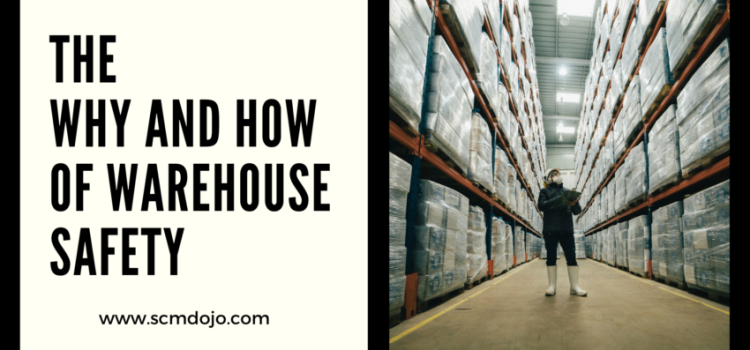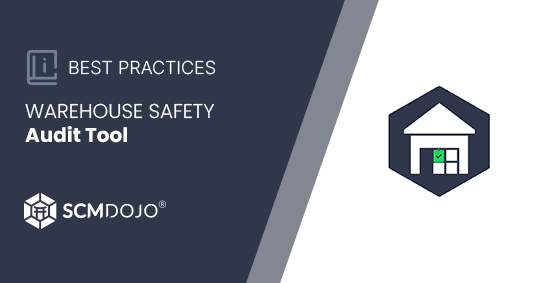Warehouses play a vital part in the distribution process employed by most distributors, exporters, importers, manufacturers, and more. With several influential pieces of equipment needed to increase efficiency and productivity, similar records reports of increased risks and workplace hazards. For example, Logiwa reports 25% of all workplace injury claims are due to slips and falls. A comprehensive warehouse safety checklist can help reduce these injuries.
Warehouses are among the dangerous places to work owing to the movement of machinery handling heavy loads. In the United States of America, warehouse workers have witnessed a massive increase of over 1,000,000 in total since 2018, according to the U.S. Bureau of Labor Statistics (BLS).
So, why is Warehouse Safety important?
The U.S. Department of Labor’s Occupational Health and Safety Administration (OSHA) reports warehouse in America own a disproportionately high accident rate in comparison to other sectors. OSHA also says the fatal injury rate is more than America’s national average for all workplaces.
A closer look at the Bureau of Labor Statistics (BLS) reports provides a better insight into the problems facing warehouses. Their findings support OSHA’s accounts of warehouses having more severe accidents and injury rates. The BLS also highlights these four-outstanding data from the reports:
- The yearly warehouse injury rate in the U.S. is 5 cases per 100 full-time employees.
- The rate of severe injuries stands as 3.7 cases per 100 employees.
- The cases considered less serious is given as 1.7% for warehouse employees.
- Almost all injuries recorded are notably preventable.
The 4th point highlights the importance of the Warehouse Safety Checklist. Workplaces that employ the right safety programs are more effective and suffered fewer injuries and less productivity loss. The significance of the Warehouse Safety checklist from a financial perspective also shows most businesses cannot pay for the outcomes of an unsafe workplace. The Liberty Mutual Research Institute for Safety estimate American firms lose $62 billion yearly due to workplace injuries. A large part of this is due to safety violations instigating more expenses from disability expenditures, lost time, medical treatment, and more. Also, a potential legal battle may arise stemming from workplace accidents. Litigation and lawsuit payouts are a possibility as well.
Who takes responsibility for Warehouse Safety?
The importance of working without harm is perhaps the most vital and morally right approach in maintaining a safe workplace. Everybody involved in warehouse operations is responsible for ensuring safety within the workplace. From the managers, and supervisors to the employees, it all comes to going home safely. Creating reasonable plans and best practices for warehouse safety is ethically correct. So how can you ensure the warehousing work environment is safe?
Warehouse Safety Checklist- 14 Categories to Consider
The warehouse working environments feature several potential hazards, like moving forklifts, slips and falls, and more. Supervisors and workers must follow suitable warehouse safety checlist and be aware of their surroundings. As a warehouse manager/supervisor, you need to be on top to address warehouse safety; this is one of the most important interview questions when you hire a logistics or warehouse manager.
Creating a safe work environment implies establishing clear and practical warehouse safety guidelines to aid every party involved. A proper approach is understanding:
- The warehouse comprises several hazards and openings for accidents/injuries.
- Warehouse hazards can transpire within moments, depending on the tasks performed.
- Warehouse equipment and materials handling require a clear and concise process.
The best warehouse safety audits and practices focus on recognizing hazards and employing methods to reduce workers’ exposure to the identified risks. Prevention of accidents is a primary component in every Warehouse Safety Audit.
Get Warehouse Safety Audit Tool
For warehouse working environments, the 14 Warehouse Safety Categories to Consider include:
- Warehouse General Safety and Materials Handling
- Forklift Operator Safety Checklist
- Warehouse Forklift Safety
- Back Safety & Lifting
- Loading Dock Safety
- Floor/ Walking and Working Surfaces
- Warehouse Racking And Storage / Pallets/Racks/Storage Practices
- Fire Equipment/Exits
- Fire Hazards
- Hazardous Materials/ Hazard Communication/Chemical Safety
- Ladders
- Electrical Safety
- Compressed Gas Cylinders
- Warehouse – COVID-19
All workplaces experience some level of mishaps. Ensuring a warehouse is safe and healthy to work in is everybody’s business — from the top management down to the employees.
Warehouse General Safety and Materials Handling
The warehouse holds both stocks and several hazards. For materials handling, either manual or powered equipment can cause a variety of injuries. In creating a safe warehouse, the general warehouse safety and materials handling process must be well-defined with vital basic rules and decent housekeeping practice. All the potential hazards are well categorized into several OSHA standards to help control warehouse operations. For instance:
- Material handling and storage rules
- Regulations for walking and working surfaces
- Regulations guiding the selection/use of PPE
OSHA offers an outstanding framework for warehouse safety programs with its publication titled the OSHA Pocket Guide Worker Safety Series – Warehousing.
To maintain Warehouse General Safety and Materials Handling, some questions to answer includes:
- Do proper work practices take place regularly?
- Do you have new recommendations you want to be factored into existing practice?
- Do other employees take part in proper work practice?
- Are proper work practices factored into performing the task(s)?
Forklift Operator Safety Checklist
The forklift is considered one of the most dangerous equipment within the warehouse. OSHA report about 100 warehouse fatalities and 95,000 injuries ensue from forklift-related accidents yearly in America. The recommended solutions by OSHA towards averting forklift hazards entails regular training for operators, detailed maintenance programs for forklift in prime condition, and use of only experienced forklift operators.
To maintain Forklift Operator Safety, some questions to answer includes:
- Does the operator completely understand the capacity information plate?
- Does the operator understand the correct fault reporting measures?
- Does the operator finish the safety Pre-shift safety inspection correctly?
Warehouse Forklift Safety
OSHA estimates 1 in 10 forklifts are involved in an accident yearly. OSHA’s statistics on the causes of fatal forklift accidents show that forklifts account for a lot of hazards and injuries. It is essential to have forklift operators trained and certified. Additionally, penalties must be in place for operators who fail to take precautions and follow guidelines for the forklift. Also, the use of caution and appropriate signage is recommended. Employees under OSHA certification must complete a refresher course or recertification every three years.
To maintain Warehouse Forklift Safety, some questions to answer include:
- Do the operator(s) own a valid training certificate passed/refreshed within the last three years?
- Do the operator(s) own a signed up-to-date authorization to operate with annual renewal?
- Are the powered industrial trucks (forklifts) in Good condition (i.e., no splinters)?
Back Safety & Lifting
Poor posture during lifting or handling of heavy loads can cause chronic pains and injuries. The following are signs employee would need assistance:
- Any difficulty noticed in grasping/lifting load.
- Cannot see around/over the load been carried.
- Less confidence in the safe handling of loads.
Using ergonomic and task-specific training would aid in averting physical injuries from manual lifting and handling. Also, ensure your employees are adequately equipped and encourage teamwork to help with the proper movement of heavy loads.
To maintain Back Safety & Lifting, some questions to answer includes:
- Are workers observed to partake in improper lifting (i.e., bending the back, not at the knees, etc.)?
- Are workers trained to report ergonomic stress (i.e., back pain, strains, sprains, etc.?
- Are Supervisors (and Lead workers) aware of ergonomic risk factors (i.e., awkward postures, repetitive tasks, etc.)?
Warehouse Safety Audit Tool
Loading Dock Safety
The American Supply Association reports 25% of all industrial accidents to occur at the loading dock. Operational forklifts at the docks are also known to fall quickly and result in injuries. A decent approach ensures all employees partaking in dock related operations are carefully trained in forklift usage, dock plate, and load support systems. Also, visual warnings are necessary around the docks and signs prohibiting employees from “dock jumping.” A good recommendation from OSHA includes painting the edge of your docks to improve visibility.
To maintain Loading Dock Safety, some questions to answer includes:
- Are employees trained not to “dock jump”?
- Are “Dock Lock” systems functional and maintained in working order?
- Are chocks installed on trailers before loading?
Floor/ Walking and Working Surfaces
Floor/ Walking and Working Surfaces are prone to slips, trips, and falls as most of its warehouse accidents. EHS reports they are responsible for 15% of all accidental deaths (second only to cars). The practice of good housekeeping is vital to enhance safety-related to working surfaces. Also, good housekeeping lets employees function more effectively. OSHA also recommends ensuring exposed employees receive training on fall hazards.
To maintain Floor/ Walking and Working Surfaces, some questions to answer includes:
- Are the aisles, passageways, and stairwells appropriately illuminated?
- Are employees on walk/work surfaces protected from tripping or stepping into through holes (including skylights)?
- Are the hallways, stairwells, and lobbies kept free from unwanted obstructions?
Warehouse Racking and Storage / PALLETS/RACKS/STORAGE PRACTICES
The failure to properly store materials can lead to several problems, including trips and slips. Different goods and raw materials within the warehouse would involve various environmental necessities of storage. For perishable goods, having a well-ventilated space would lessen the likelihood of spoilage. There are different standards for warehouse racking and storage, which include storage areas being kept free from the accumulation of materials that constitute hazards.
To maintain Warehouse Racking and Storage / Pallets/Racks/Storage Practices, some questions to answer include:
- Are the tiers provided stacked, blocked, interlocked, and limited in height to deliver stable and secure storage?
- Are bags, boxes, containers, bundles, etc. stored in tiers to prevent sliding or collapse?
- Are adequate safe clearances maintained for aisles?
Fire Equipment/Exits
All warehouses feature lots of open space, which may allow a fire to spread rapidly. Two thousand one hundred thirty-one fires were recorded in 2015/16 within industrial premises (including warehouses) with several fatal and non-fatal casualties. Beyond the damage to warehouses, fire harming employees is often the biggest challenge. The outcomes are always filled with uncertainties, and several businesses never fully recover from a severe fire. Fire drills, fire alarms, fire equipment, and exits are all part of good warehouse practice to keep employees and employers safe. Proper fire equipment and training on how to use them are essential. EHS recommends the use of adequately selected fire extinguishers to be well-mounted and routinely inspected.
To maintain Fire Equipment/Exits, some questions to answer includes:
- Are there regular reviews of the Emergency Management Plan?
- Are occasional drills organized on the use of fire equipment/exits?
- Are there emergency escape routes available in the workplace environment?
Fire Hazards
The report Structure Fires in Warehouse Properties by the National Fire Protection Association (NFPA) in January 2016 highlights that
“fires between 2009 and 2013 caused an annual average of $155 million in direct property damage”.
Fire hazards within the warehouse are hazards involving the presence of flames or uncontrolled fire risks. Some Fire hazards to avoid within the warehouse include flammable chemicals, hot objects, live flames, sparks, and more. Identifiable fire hazards within the warehouse should be handled, and employees trained to manage them in cases where it becomes necessary.
To maintain Fire Hazards, some questions to answer include:
- Are workers trained in the identification of fire types and safe practices?
- Are reviews of fire prevention practices carried out within the workplace?
- Is there adequate provision of fire protection systems?
Hazardous Materials/ Hazard Communication/Chemical Safety
Warehouses containing hazardous chemicals come with enormous responsibility. OSHA reports that 2018 saw everything from a chemical explosion fatality to frostbite from exposure to liquid ammonia. A good practice for warehouse operators is to evaluate all potentially hazardous chemicals and ensure proper training for all employees charged with handling them. Additionally, every material considered dangerous should be well labelled to contain a Safety Data Sheet (SDS).
To maintain Hazardous Materials/ Hazard Communication/Chemical Safety, some questions to answer include:
- Are employees provided information and training on hazardous chemicals?
- Is there an initial assessment whenever a new hazard is presented in the workplace?
- Does the workplace have a written Hazard Communication (HAZCOM) Program?
Ladders
EHS reports the U.S. records an estimate of 300 deaths, 30,000 disabilities, and 130,000 injuries yearly from accidents involving ladders. The primary causes identified are: ladders in poor condition, incorrectly positioned, uneven surfaces, poorly located, and more. Ladder safety is predominantly vital due to several reports of misuse recorded amongst employees. A safe approach is to ensure all employees are trained on the proper use of ladders. The key to safely using a ladder is selecting the right one, applying a stable set-up, and focusing on suitable work techniques.
To maintain Ladder safety, some questions to answer include:
- Are the ladders in use considered to be in a safe condition (safety feet, rungs, bracing, etc.)?
- Does the ladder come with a non-slip surface on rungs?
- Do employees receive training on the proper use and types of ladders?

Electrical Safety
Electricity in workplaces (like a warehouse) can present many-body hazards resulting in severe injuries and death. It is vital to understand the basic principles behind the different energy sources used in the warehouse, recognize them, and protect against the possible hazards they produce. Other cordless machinery needing charging stations should be well-identified as they carry explosion and fire risks. Personal Protective Equipment (PPE) should also be encouraged, especially in cases of battery fluids leak. Batteries are known to have corrosive liquids, like sulfuric acid. OSHA Electrical Overview and OSHA Electrical Fact Sheet are some recommendations to help define your warehouse electrical safety.
To maintain electrical safety, some questions to answer include in the Warehouse Safety checklist:
- Are there proper identification and signs for electrical hazards (shock, fire, overloading)?
- Is there proper training for workers on how to handle electrical hazards?
- Are there regular reviews of electrical maintenance systems and practices?
Compressed Gas Cylinders
The penalties for mishandling compressed gas cylinders are positively terrible. EHS Today reports back sprains and strains injuries are the second-most common issues relating to compressed gas containers. The Bureau of Labor Statistics reports pressurized containers resulted in 6,280 non-fatal injuries within the U.S. in 2014, with 1,700 of the injuries leading the affected employee to miss over four weeks of work. OSHA workplace safety for compressed gas cylinders helps create safe-handling standards.
To maintain compressed gas cylinders, some questions to answer include:
- Are the contents of gas cylinders identified?
- Are gas cylinders stored properly (capped, chained, secured)?
- Are employees trained on proper handling procedures for the cylinders?
Warehouse – COVID-19
COVID-19 has already altered the warehouse environment and has a massive impact on the global supply chain; therefore, included in this Warehouse Safety checklist. The ‘Working safely during COVID-19 in factories, plants, and warehouses‘ document published on May 11 remains a useful guide for employers and employees involved in warehouse processes. It’s important to follow set out guidelines dependent on your location.
To maintain Warehouse – COVID-19, some questions to answer include:
- Are entrance and Car Park social distancing rules duly followed?
- Are vital signs visible at the site entrance?
- Is signage on display at the reception?
- Temperature Check is done at the reception before entrance?
- Facemask is being worn before the entry of the warehouse?
Conclusion- Warehouse Safety Checklist
The warehouse safety audit is an essential aspect of maintaining or improving your warehouse performance, which you can download from here and use it every quarter if not every month. Employees and employers finding a good middle ground in work efforts are vital to creating better outcomes and ensuring everyone is safe.
Hopefully, the warehouse safety checklist is helpful to you and your business in the long and short term.
About the Author- Dr Muddassir Ahmed
Dr MuddassirAhmed is the Founder & CEO of SCMDOJO. He is a global speaker, vlogger and supply chain industry expert with 17 years of experience in the Manufacturing Industry in the UK, Europe, the Middle East and South East Asia in various Supply Chain leadership roles. Dr. Muddassir has received a PhD in Management Science from Lancaster University Management School. Muddassir is a Six Sigma black belt and founded the leading supply chain platform SCMDOJO to enable supply chain professionals and teams to thrive by providing best-in-class knowledge content, tools and access to experts.
You can follow him on LinkedIn, Facebook, Twitter or Instagram







